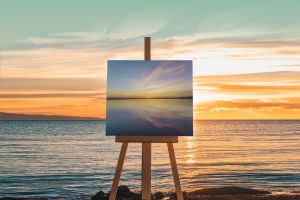Spring's here, and nothing screams spring louder than blooming flowers. It's the perfect time to grab our cameras (or phones!) and capture those colorful petals.
But let's be real—snapping flowers that actually look good isn't always easy. Ever tried to take a photo and ended up with messy backgrounds or a dull, flat image? Yep, we've been there too.
So today, we're sharing 6 simple and practical flower photography tips that'll help us take clean, eye-catching flower shots—just like a pro.
Choose the Right Metering Mode
If we're taking photos with the sun behind the flower or with the sky as a backdrop, chances are the flower will look too dark (aka underexposed). In that case, we've got two options: either use a reflector to bounce light back onto the flower, or switch our camera to spot metering mode.
Why spot metering? Because it only measures light in a small area—about 9% of the frame. That means we can tell the camera exactly where to measure the light, especially helpful when there's a big difference between the light and dark parts of the shot.
Here's a tip: If we want to save details in the brightest part (like white petals), we can point the camera at that bright area, lock the exposure, and then reframe to shoot.
If the lighting is nice and even, though, we can go with center-weighted or evaluative metering for a more balanced shot.
Use a Wide Aperture to Blur the Background
A common mistake we all make at the beginning? Shooting too many flowers in one frame, and forgetting about the messy background. When the background's cluttered or full of random colors, it steals attention from the main flower we're trying to show off.
Instead, let's pick a clean and simple background—something with one or two main colors. If we can't find one, no worries! Just use a wide aperture (like f/2.8 or f/4) to blur it out. A blurry background doesn't just clean up the shot—it makes the flower pop and look way more professional.
Master the Art of Composition
Good composition can totally upgrade a flower photo, even if the lighting or camera isn't perfect. There are a few basic techniques we can use:
1. Diagonal composition: Best for flowers growing on branches or vines. The diagonal angle adds movement and flow.
2. Rule of thirds (aka the 3x3 grid): Place the flower off-center, and leave some space to “breathe.” It feels more natural and balanced.
3. Center composition: Works great for macro (close-up) shots where the flower fills the frame.
4. Foreground framing: Use a nearby flower or leaf to create a frame—it adds depth and layers to our photo.
These four are just the beginning, but they're the foundation for beautiful, well-composed flower shots.
Play with Light—Front, Back, and Side
Lighting can change the vibe of a flower photo completely. Let's look at three common types:
Front light (sun behind you): Gives us bright, clean, colorful shots. Great for showing off the true color of the petals, but can sometimes feel a bit flat.
Backlight (sun behind the flower): Makes the petals glow! This creates a dreamy, soft effect and makes the flower look almost see-through. It also outlines the shape beautifully.
Side light: Adds shadows and depth, kinda like backlight, but with a bit more contrast.
No matter the lighting, don't be afraid to experiment. Sometimes the best photos come from playing around.
Use Exposure Compensation for White Flowers
Ever noticed how white flowers sometimes look dull or gray in photos? That's because our cameras often underexpose them to “protect” the whites.
The fix? Use the “add white, reduce black” rule—for white flowers, we should bump up the exposure compensation by one or two stops (+1.0EV to +2.0EV). That way, the petals look bright and pure, not shadowy and sad.
Give it a try—compare a white flower photo with and without exposure compensation. The difference is super noticeable!
How to Create a Beautiful Black Background
A black background can make any flower look like a piece of art. And the cool part? We don't need a fancy studio to do it.
Here are 3 easy ways we can get that clean black background:
1. Use props: Grab a piece of black cloth or an umbrella and place it behind the flower. With the right camera settings (like a wide aperture and close-up focus), the background will blur into deep black.
2. Control your exposure: Use spot metering to measure light on the brightest part of the flower, then underexpose slightly (around -1.0EV). That'll keep the flower bright and turn the background dark.
3. Choose dark places: Look for shady spots or areas where the background is already dark. Place the flower in sunlight or bright light, then shoot with a medium aperture to keep the flower sharp and the background soft and black.
With a bit of practice, we can turn almost any garden corner into a mini studio!
Let's Get Out There and Snap Some Flowers, Lykkers!
That's it—six easy and practical flower photography tips that'll seriously level up our shots this spring. Whether we're using a DSLR or just our phones, these tips help us work with light, background, and composition like a pro.
So next time we see a blooming rose or a field of tulips, let's pause, frame it right, and snap something magical. And hey—if you try out these tips, come back and share your favorite photo. We'd love to see what beauty you capture out there!
Happy shooting, Lykkers 🌸📸


